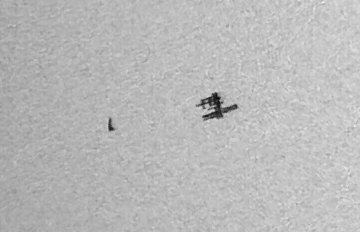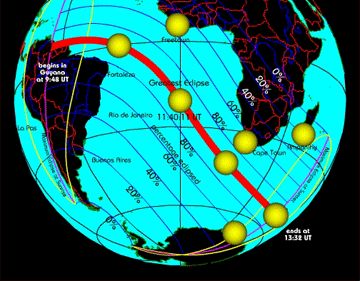 The space shuttle is in orbit. We can call you when it's about to fly over your hometown: Spaceweather PHONE.
The space shuttle is in orbit. We can call you when it's about to fly over your hometown: Spaceweather PHONE.
AURORA WATCH: Sky watchers in Alaska, Canada and Scandinavia should be alert for auroras tonight. A solar wind stream is buffeting Earth's magnetic field and causing mild geomagnetic storms.
SPACESHIP SILHOUETTES: Yesterday, the space shuttle Atlantis undocked from the International Space Station (ISS). Amateur astronomer Thierry Legault caught the two spaceships separating directly in front of the sun:

"I took this picture from Normandy, France, at 1340 UT on Sept. 17th while the shuttle was performing a 360° inspection of the ISS," says Legault.
If you think the silhouette of the ISS looks a bit different, you're right. The ISS has a new set of solar arrays. The crew of Atlantis installed the 240-ft wings during their ten-day mission: more.
SOLAR ECLIPSE: When the day begins in South America on Friday, Sept. 22nd, something won't be quite right: the rising sun will be shaped like a crescent. It's the beginning of an annular solar eclipse:

Image credit: Larry Koehn.
Annular eclipses occur when the Moon passes straight in front of the sun but fails to cover the entire solar disk. A sliver of sun pokes out in all directions producing a vivid ring of fire. This is what's going to happen on Friday.
Unfortunately, almost all of the eclipse takes place over uninhabited ocean. The red line in Larry Koehn's map, above, traces the "path of annularity" where the sun will become a ring for about 7 minutes. Only in a tiny swath of Guyana, Surinam and French Guiana will the ring of fire be visible from land: animated map (courtesy Larry Koehn).
Elsewhere, the Moon will cross the sun off-center, producing not a ring but a crescent. At daybreak, people in South America will see a crescent sunrise; later in the day crescent sunbeams will dapple the ground in Africa. Click here for timetables and other details.

